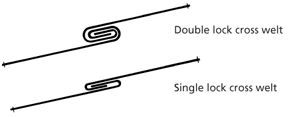Transverse Laps
The double lock cross welt should be used in all cases where severe weather conditions exist. Where the pitch is below 20°, the edges of the metal forming the double lock cross welt should be soldered or sealed with silicone sealant before closing the welts and seams and folding together.
Cross welts used with standing seams should be staggered in adjoining bays to compensate for the increase in thickness of many-layered metal, but batten roll joints from ridge to eaves may be used in a continuous line across a roof.
Although a long strip roof can be laid entirely using conventional hand tools, power or hand operated machines are used on long panels to save time.
All joints in weathering details for penetrations, rainwater heads, stop ends, and expansion flashings in sheet copper should be sealed by brazing with silver solder. In zinc, all joints should be sealed using lead/tin soldering. All metals should be mechanically locked before sealing.
All transverse and longitudinal joints on fully supported metal roof and wall cladding must only be welted, lock seamed or capped, and must not be joined solely by soft soldering, welding or brazing.
Where the direction of fall is diagonal to the standing seam and welts, the laying direction of the bays must be away from the flow.
Where rainwater will drain to one side of the bays, high-velocity streams of water flowing down the seams and welts should be directed away from the seamed side of the panel.
Light gauge wide pan widths should be avoided because they give rise to sheet drumming and consequential fatigue.
- Log in to post comments

